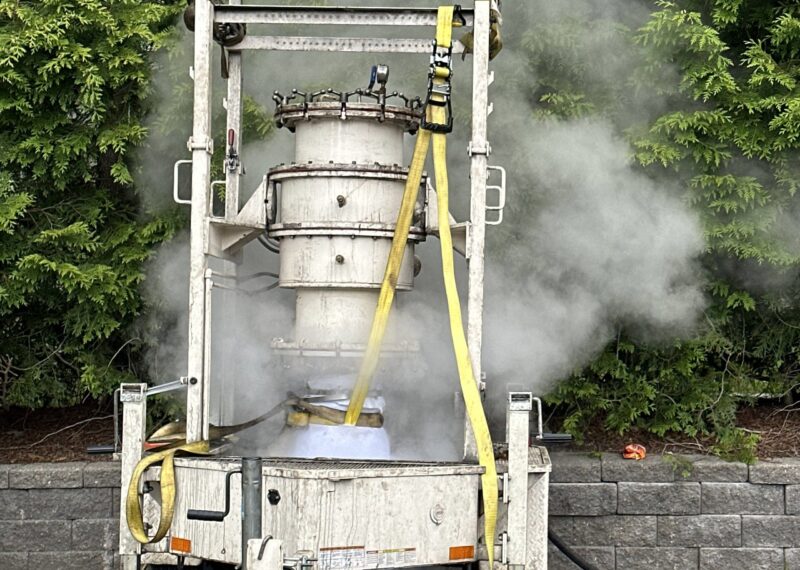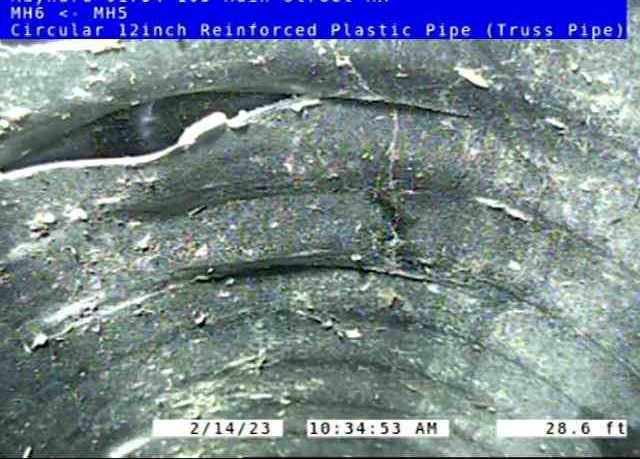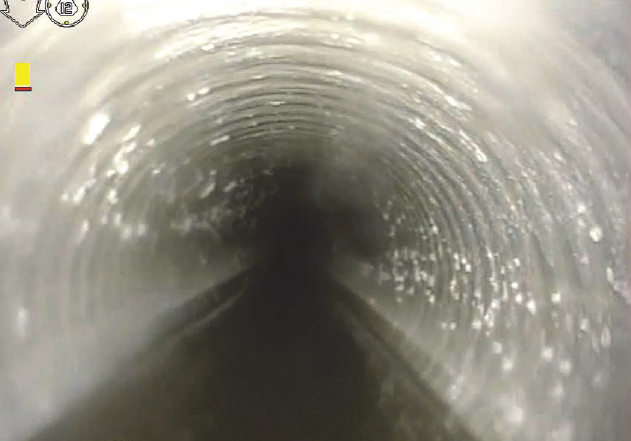Maynard, Mass. Underground Pipe Inspection
Maynard, Mass. |
Retail |
CCTV Pipe Inspections
Overview:
During routine inspection, the Town of Maynard, Mass. found pollutants leaving this retail site. To remediate the issue the stormwater pipes were inspected, cleaned and repaired.
Problem:
During a routine investigation of the Town’s drainage infrastructure, water quality testing found excess nutrients in the water leaving a retail property in the Town of Maynard, resulting in a Notice of Violation (NOV). The NOV required the property to develop a plan for removing the pollutants within 30 days and eliminate the issue within 90 days. If this was not accomplished, the property was at risk of fines up to $300 a day until remediation. The true source of the pollutants was unknown, so the property owner relied on AQUALIS to investigate and remedy the issue in a timely manner.

Utility van for monitoring CCTV

Liner for pipe repair

Installing the new pipe

Installing the new pipe

Before

After
Solution:
To understand the severity of the issue, AQUALIS mobilized underground camera equipment, called CCTV, to the site to investigate the stormwater infrastructure. Underground camera inspections are conducted with a small, rolling camera that is remotely controlled to visualize the inside of pipes without excavation or physical entry. This trenchless technology allowed a technician to navigate the pipes by displaying the video feed on a monitor above ground. The video was also recorded for future reference. The rolling camera was connected to equipment above ground inside a utility van where the video display is held. Because of this connection, there are limitations to the length of pipe that can be explored at one time. Due to the exploratory nature of this repair, AQUALIS thoroughly inspected all underground pipes from multiple access points.
After inspecting the underground pipes, AQUALIS determined the pipes needed to be cleared for any repairs to be effective. Underground pipes are best cleaned using industrial vacuumation and jetting. Jetting includes sending high pressure water through the pipes via an access point like a manhole. The force of water loosens obstructions like roots and accumulated sediment and carries it downstream. The sludge is then vacuumed out into a storage tank to be properly disposed of at a treatment plant. Once the pipes were appropriately cleaned, they could be inspected for damages.
Through CCTV, AQUALIS inspected over three hundred feet of pipe to identify where infrastructure was compromised once it was cleaned. The camera investigation showed leaching as external water seeped into the stormwater pipe. Leaching is a type of corrosion where the pipe degrades over time and the metal begins to thin, allowing materials to flow either into or out of the pipe. In addition to this, the camera found places where joints had separated and fractured allowing a flow of groundwater to enter and carry high levels of contaminants downstream.
To repair the structural integrity of the pipe in a cost-effective manner, AQUALIS used a technique called pipe lining, commonly referred to as CIPP (curing in place pipe). Lining the length of the pipe effectively stops all entry points of contamination without replacing hundreds of feet of pipe. To line the pipes, a thin liner was inserted into the pipe and carried to the downstream access point. Once properly laid inside, air was pushed through the liner causing pressure to push the liner snug along the inside of the pipe. The liner was cured in place with resin which created a new barrier protecting the pipe from any external water. This choice is more efficient than replacing pipe as it can be done without excavation or entry. The liner can be made of various materials, often polyester or carbon fiber. The repaired pipe is now resistant to corrosion and all fractures and separations are sealed.
After the new cured in place pipe (CIPP) was installed, AQUALIS reinspected the area with additional CCTV to ensure the repair was successful. Visualizing the infrastructure after each phase of work ensured that no issue was overlooked, and all stages were successful.
Working swiftly, AQUALIS was able to eliminate the pollutants that led to the initial NOV without accruing fines. Partnering with the sustainable water experts will ensure your NOV will be corrected and your property will return to compliance. Avoid extraneous fines by requesting a FREE consultation today.
 Kenosha, Wis. Highway KR Regenerative Stormwater ConveyanceThe Root-Pike Watershed Initiative Network Kenosha County, and others worked with AQUALIS to design and implement an innovative solution for stormwater control along Highway KR.
Kenosha, Wis. Highway KR Regenerative Stormwater ConveyanceThe Root-Pike Watershed Initiative Network Kenosha County, and others worked with AQUALIS to design and implement an innovative solution for stormwater control along Highway KR. Durham, N.C. Sinkhole Leads to Stormwater System RehabilitationThe tenant on this property noticed a depression that opened to the ground below and notified the property owners.
Durham, N.C. Sinkhole Leads to Stormwater System RehabilitationThe tenant on this property noticed a depression that opened to the ground below and notified the property owners.







